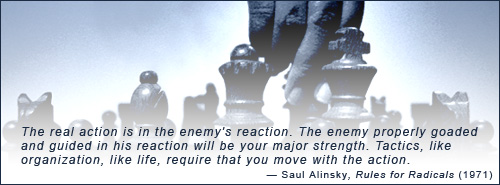| Rule 1: |
Power is not only what you have but what an opponent thinks you have. |
| Rule 2: |
Never go outside the experience of your people. When an action or tactic is outside the experience of the people, the result is confusion, fear, and retreat. |
| Rule 3: |
Wherever possible go outside the experience of the enemy. Here you want to cause confusion, fear, and retreat. |
| Rule 4: |
Make the enemy live up to their own book of rules. |
| Rule 5: |
Ridicule is man's most potent weapon. It is almost impossible to counterattack ridicule. Also it infuriates the opposition, who then react to your advantage. |
| Rule 6: |
A good tactic is one your people enjoy. If your people are not having a ball doing it, there is something very wrong with the tactic. |
| Rule 7: |
A tactic that drags on too long becomes a drag. |
| Rule 8: |
Keep the pressure on, with different tactics and actions, and use all events of the period for your purpose. |
| Rule 9: |
The threat [of action] is usually more terrifying than the thing itself. |
| Rule 10: |
The major premise for tactics is the development of operations that will maintain a constant pressure upon the opposition. The pressure produces the reaction, and constant pressure sustains action. |
| Rule 11: |
If you push a negative hard and deep enough it will break through into its counterside; this is based on the principle that every positive has its negative. We have already seen the conversion of the negative into the positive, in Mahatma Gandhi's development of the tactic of passive resistance. |
| Rule 12: |
The price of a successful attack is a constructive alternative. You cannot risk being trapped by the opponent in his sudden agreement with your demand and saying "You're right – we don't know what to do about this issue. Now you tell us." |
| Rule 13: |
Pick the target, freeze it, personalize it, and polarize it. "He that is not with me is against me" (Luke 11:23). |

